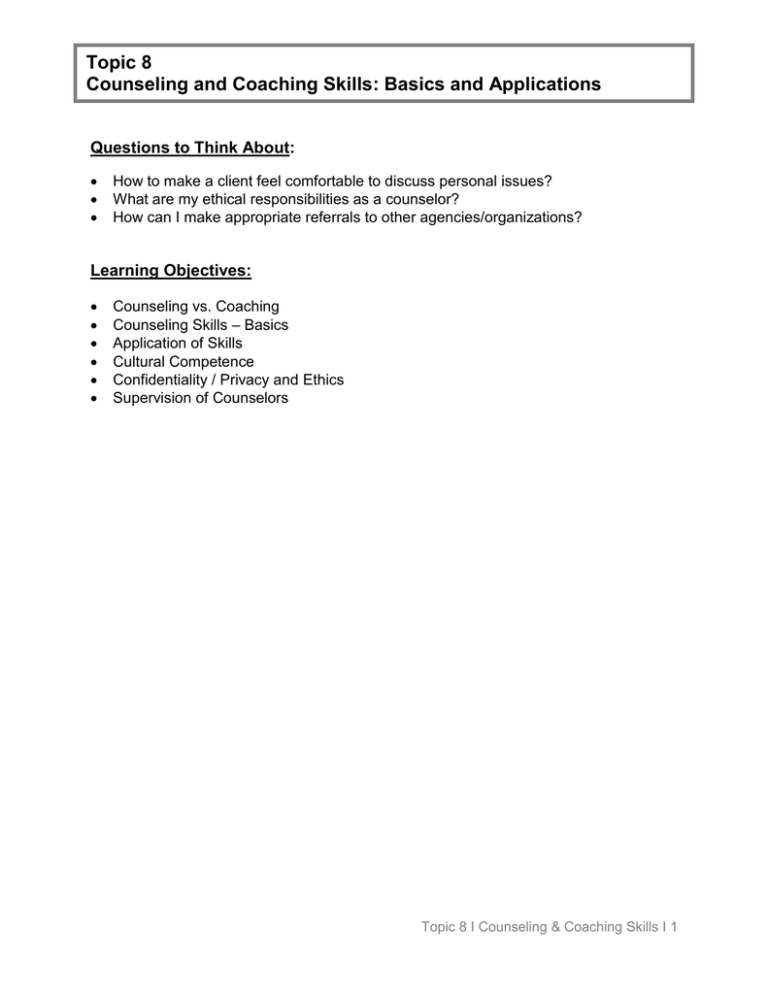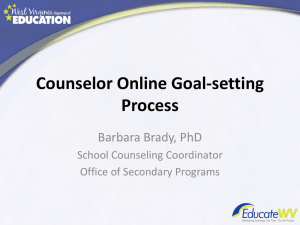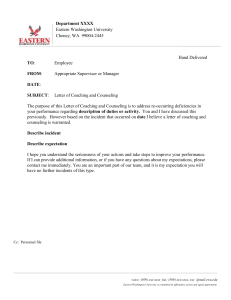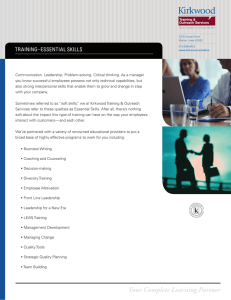
Topic 8
Counseling and Coaching Skills: Basics and Applications
Questions to Think About:
How to make a client feel comfortable to discuss personal issues?
What are my ethical responsibilities as a counselor?
How can I make appropriate referrals to other agencies/organizations?
Learning Objectives:
Counseling vs. Coaching
Counseling Skills – Basics
Application of Skills
Cultural Competence
Confidentiality / Privacy and Ethics
Supervision of Counselors
Topic 8 I Counseling & Coaching Skills I 1
NOTE: If applicable, when seeing only one spouse, it’s
advisable to bring in the other spouse if this is the one
with the only income in the household. Make sure to
make both sides feel like they’re playing a role in creating
the budget and figuring out the issues and coming up
with a solution.
Topic 8 I Counseling & Coaching Skills I 2
ATTENDING
Being Present
Orient oneself physically and psychologically
Give undivided attention to client:
When s/he is speaking
How s/he is behaving or what is being done
Purpose of Attending
Encourages the client to be open and talk
Allows the client to know that counselor is listening
Demonstrates empathy
Application of Attending
Posture of Involvement: There may be issues of culture at play
Face client squarely
Nod head
Eye contact
Relax
Appropriate Body Motion
Creating a Non-Distracting Environment
Quiet, private space
Hold phone calls and interruptions
Ask for permission if an interruption is expected
Topic 8 I Counseling & Coaching Skills I 3
ASKING THE RIGHT QUESTIONS
Two Types of Questions
Open ended question
Closed ended question
Open-Ended Questions
Questions not easily answered by “Yes,” “No,” or one- or two-word responses
Examples:
“How can I help you today?”
“Please tell me why that is?”
“What was your response to her statement?”
“What factors did you consider in that decision?”
Purpose of Open-Ended Questions
Start an interview
Engages the client
Creates opportunity for client to elaborate or be specific
Motivate clients to communicate
Closed-Ended Questions
Questions easily answered by a “Yes,” or “No,” or one- or two-word response
Examples:
“Do you have credit cards?”
“How many credit cards do you have?”
“Do you pay only the minimum balance?”
Purpose of Close-Ended Questions
To gather basic and/or specific information
To quickly assess parameters or breadth of the issue or case
To focus the topic discussion
To guide a client who is too scattered
Topic 8 I Counseling & Coaching Skills I 4
PARAPHRASING
Counselor confirms the content or substance of the client’s message
Examples:
Client:
Counselor:
“I’m paying more than the minimum payment on my highest interest rate
card.”
“Your strategy of paying off the higher interest rate cards is a good one.”
Purpose of Paraphrasing
Informs client that counselor is listening and understand
Reinforces and clarifies points for client
Encourage the client to elaborate
Validates client’s perspective or position
Allows counselor to confirm accuracy of perceptions
Application of Paraphrasing
Clarify issues for counselor, e.g. large amounts of information is involved
Ascertain what is going on with client – dynamics, reactions to events outside of issue at
hand
Help client to clarify thoughts when making a decision
Responses to Avoid
Minimizing concern or being dismissive
Analyzing and Interpreting
Giving over-simplified advice
Pronouncing judgment
Topic 8 I Counseling & Coaching Skills I 5
SUMMARIZING
Highlighting or emphasizing main points
Distilling the client’s message
Purpose of Summarizing
Begin a new session with orientation; or review progress and begin on the same page
End a session – reiterate important points, orient toward future goals
Identify a common theme or pattern
NOTE: Go back to what client
To pace a session
was “assigned” to do during the
To segue to new topic
last session. Clarify any issues
Focus client’s thoughts and decide how to proceed
before moving on to the next
Agree upon basis for mutually exploring goals
topic. Additionally, bring up any
issue(s) that may have come up
since the last session.
Application of Summarizing
Paraphrase important points from content of the client’s messages
Identify patterns or themes
Use an appropriate lead in to the summary; “You seem to be saying…”
Verbalize client’s response to the summary
Gauge the effectiveness of the summarization; “How do you feel about what was just
said…”
Topic 8 I Counseling & Coaching Skills I 6
REFLECTING
Verbalizing client’s emotion based on:
Client’s verbal and non-verbal behaviors
Reasonable inferences about what the client might be experiencing emotionally
Careful choice of words required
Purpose of Reflecting
Helps clients:
Feel understood
Express more feelings
Manage feelings
Discriminate among various feelings
Application of Reflecting
Verbalize and reflect emotions back to client only after:
Listening closely to client’s verbal cues and carefully observing nonverbal behaviors
Identify the feeling the client is experiencing
Gauge the intensity of emotion
Give client feedback in the reflection
Stop to check accuracy of reflection
DIFFUSION
Identifying client’s distress when reflecting
Verbalizations reflecting client emotion aimed at calming the client and helping to re-focus
Use words to convey empathy
Topic 8 I Counseling & Coaching Skills I 7
PRIVACY
Trust relationship
Inform clients about limits of confidentiality
Limit cases discussions to private areas
Protect private documents
Document client consent for sharing information
CONFIDENTIALITY
Protect Clients’ Information
Do not disclose information to third parties without client consent, i.e. client’s family
members, colleagues, other agencies, etc.
ETHICS
Information obtained from clients or counseling sessions may not be used to the
counselor’s benefit
Avoid appearance of impropriety
Personal relationships
Financial transactions
Topic 8 I Counseling & Coaching Skills I 8
Topic 8 I Counseling & Coaching Skills I 9
Topic 8 Exercise #1
Two volunteers will act as co-counselors. Two volunteers will play the role of Lily and Joe.
Demonstrate how the counselors might handle this scenario.
Role Play
Lily is a stay at home Mom. She made an appointment to see the counselors about the
financial problems her family is having. Her husband at first refused to come with her.
Then he begrudgingly agreed to join her.
They couldn’t get a babysitter, and so they had to bring their 3 year-old daughter with
them. They got into a fender-bender just an hour before arriving 25 minutes late for their
appointment. Joe blames Lily for rushing them for the “stupid appointment”. Lily tells Joe
that if they cannot fix their financial problems caused by him running up debt, she might
divorce him. He said that she could go get a job and contribute.
© January 23, 2013
Cities for Financial Empowerment Fund
All rights reserved.
Topic 8 I Counseling & Coaching Skills I 10




